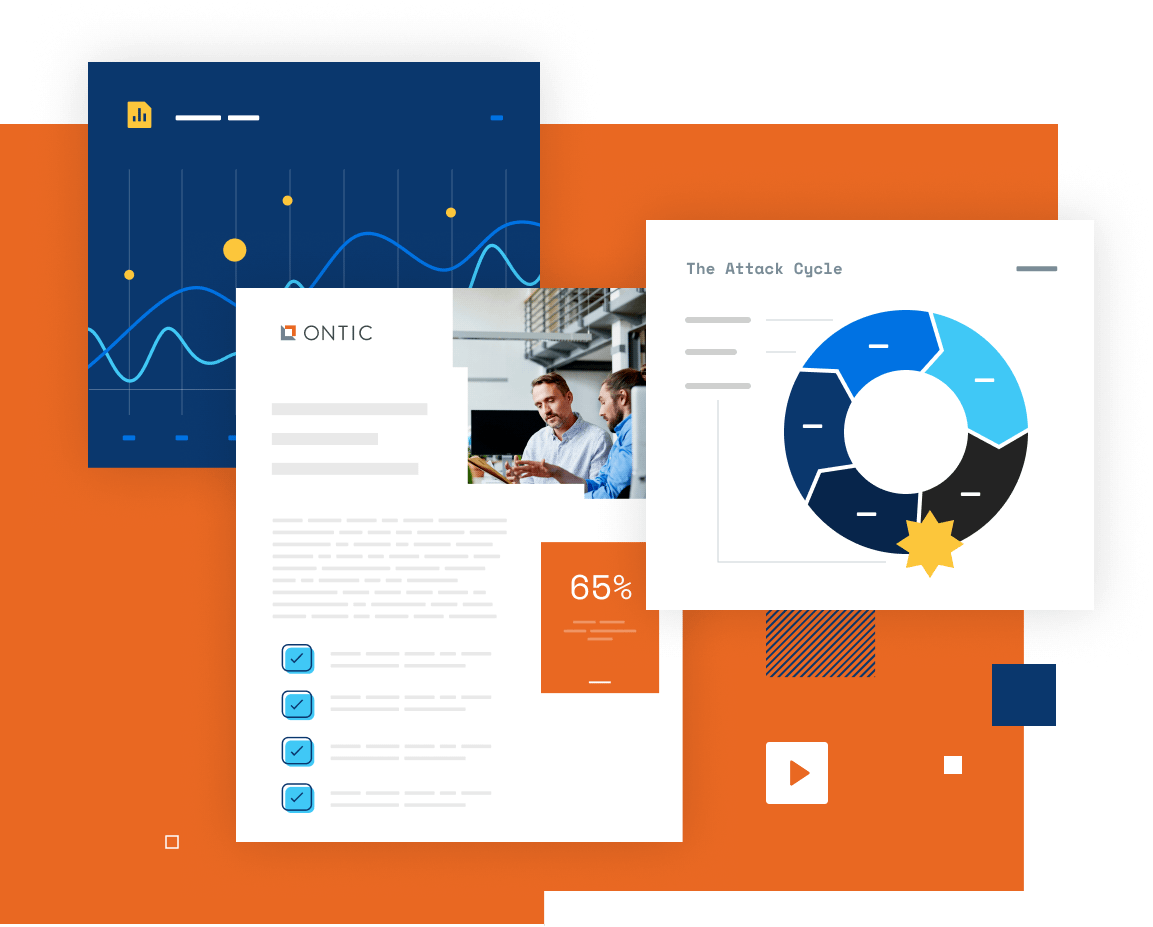Enhance Your Insider Risk Program with These 6 Systems Integrations
Learn how the right integrations close critical data gaps, helping you gain a more complete view of your organization’s insider risk

Cyber Threat Intelligence Systems
Human Resources Information Systems
Data Loss Prevention Solutions
To fully understand and mitigate your organization’s insider risk, you need insights from other departments across the business — HR, legal, IT, and others. But as you’ve likely experienced, accessing these insights can be challenging. Each department typically manages its own extensive data and systems. And this siloed structure can make it feel like you’re operating in the dark.
Leading security teams overcome this by integrating data from different sources with their security platforms — allowing insider risk stakeholders to easily view and analyze relevant data. Access to key security-related insights gives you a comprehensive, near-real-time view of your organization’s risks. This unified perspective enables you to identify threats and take action to prevent incidents or minimize their impact.
While integrations alone won’t solve all the challenges of insider risk management, they are a powerful tool to enhance your program. The goal is steady progress, as every organization has unique needs, and finding the right integrations is crucial for building a stronger program.
System integrations to explore for your insider risk program
These six integrations can enhance insider risk visibility, helping you get ahead of potential incidents and quickly mitigate their impact:
1. Cyber threat intelligence systems
What it is
Cyber threat intelligence (CTI) is crucial for understanding the broader cyber threat landscape. These systems gather and analyze information about potential cyber threats — like phishing attempts or attacks on your system.
Common systems
Crowdstrike, Flashpoint, Anomali ThreatStream
Examples of relevant data
- Indicators of compromise
- Patterns used by threat actors
- Threat actor profiles
- Phishing indicators
- Abnormal traffic patterns
Why it’s important for insider risk management
Integrating CTI into your physical security solution helps you detect cyber threats that could escalate into physical incidents — empowering you to act quickly to mitigate them. For example, maybe you notice patterns that indicate insider actors are planning a phishing attack in order to access data that could put your people or physical assets at risk. With that information integrated into your larger system for managing investigations, you can quickly research the actors and formulate a plan for preventing the incident or reducing its impact.
2. Human resources information systems
What it is
A Human Resources Information System (HRIS) is a software solution that manages and automates HR processes and data, such as employee records, payroll, and benefits administration.
Common systems
Workday, Greenhouse, PeopleSoft
Examples of relevant data
- Employment details (like job title and date of hire)
- Compensation and benefits information
- Performance reviews, goals, and career progression
- Attendance and timekeeping
- Employee relations information (like complaints)
Why it’s important for insider risk management
Much of the information tracked and monitored in an HRIS is relevant to security teams — such as performance data, role changes, and termination dates. When directly integrated with your security system, this data can help paint a clearer picture of your company’s insider risk.
For instance, employees who are scheduled for termination or have recently been put on performance improvement plans may pose a higher security risk. Integrating HRIS data with your security system gives you real-time visibility into such situations, allowing you to proactively monitor unusual behavior, cross-reference with other signals (like attempts to access restricted data), and mitigate your risk.
The best integrations between your HR and security systems foster mutual trust by giving both teams a shared view of only the necessary data. This gives you access to the information you need without compromising employee privacy.
3. Data loss prevention solutions
What it is
Data loss prevention (DLP) solutions monitor and control data transfers, preventing the unauthorized sharing or leakage of sensitive information.
Common systems
Forcepoint, Symantec, Proofpoint
Examples of relevant data
- Unauthorized access or exfiltration of confidential data (like PII or health records)
- Data at rest, in motion, or in use
- File metadata
- Contents of outgoing and incoming emails and attachments
- Other user actions (like copying data onto a USB drive)
Why it’s important for insider risk management
Integrating with a DLP system gives you insight into data sharing and access patterns, helping you gain a more complete picture of a potential threat and bridging the gap between cyber and physical security.
For example, your DLP integration might detect suspicious data-sharing patterns by an employee. This might not indicate a threat on its own — it could simply be an accident. However, when combined with other information, such as a recent performance review showing that the employee was passed over for a promotion, a more complete picture emerges. These combined signals might suggest a potential physical security risk, prompting further investigation.
4. Inventory management systems
What it is
An inventory management system is a software solution used to track, manage, and optimize the flow of goods throughout a business. It monitors stock levels, orders, sales, and deliveries, ensuring that the right amount of inventory is available at the right time.
Common systems
Cin7, Zoho, Oracle NetSuite
Examples of relevant data
- Product IDs and SKUs
- Inventory levels
- Inventory movements (like stock in and stock out)
- Warehouse and storage information
- Inventory valuation and costs
Why it’s important for insider risk management
When integrated with your physical security system, inventory management systems provide yet another signal that can help paint the full picture of insider risk. For instance, if an inventory anomaly occurs, the integration of these systems allows for immediate cross-referencing with HR or other security data, reducing the time it takes to identify whether this was a mistake or a potential insider event that warrants further investigation. If an investigation is required, you can quickly and easily manage the next steps within one central system, such as conducting further POI research or creating reports for law enforcement.
5. Access control and visitor management systems
What it is
Access control or visitor management systems monitor physical access to your organization’s premises.
Common systems
Envoy, Sign In Enterprise, Genetec
Examples of relevant data
- Employee access levels and permissions
- Employee work schedules
- Visitor information (like name and purpose of visit)
- Access time stamps and duration
- Badge and credential data
Why it’s important for insider risk management
Integration between these systems and your security solution allows for tighter control over who is allowed access to specific areas. When someone checks in through the visitor management system, the physical security solution can grant or restrict access based on pre-defined rules, ensuring that only authorized visitors can enter sensitive areas.
This integration can also provide added signals to your overall picture of risk. You can monitor for unusual patterns, such as an employee making repeated attempts to access restricted areas. Combining this data with other signals (like unusual credit card transactions) can provide a more comprehensive view of potential risks.
6. License plate recognition and video management systems
What it is
License plate recognition (LPR) or video management systems can monitor vehicle movements near your premises, providing even more insights into potential risks.
Common systems
Avigilon, OpenALPR, Rhombus
Examples of relevant data
- License plate data and vehicle information
- Timestamps of vehicle entries and exits
- Records of previous vehicle entries and exits
- Motion detection and alarm timestamps
Why it’s important for insider risk management
Like the other integrations, this vehicle data alone may not indicate a significant threat. But combining it with other data points you’ve integrated into your system (like access control and HR information) ensures that you are equipped to proactively prevent larger incidents from occurring or more thoroughly investigate active insider cases.
Integrations and collaboration go hand-in-hand
While system integrations are crucial, setting them up is rarely straightforward. Since you likely do not own these systems, you’ll need to cultivate strong relationships with the teams that do. It’s also essential to clearly articulate how these integrations will benefit everyone involved.
Start building these relationships by getting face time. This could be as simple as a tabletop exercise demonstrating the value of using integrated data to address insider risk. It’s also important to understand each team’s broader goals and identify common objectives that can help foster a closer working relationship. For example, HR is typically responsible for ensuring employee satisfaction and well-being. Effective insider risk management supports this goal by preventing incidents that could emotionally or physically harm employees.
Even with the right integrations in place, they are just one part of the insider risk management puzzle. While integrations provide connected data, effective insider risk management also requires data analysis and contextualization, timely responses, thorough investigations, and incident mitigation — all of which depend on strong collaboration across teams.
Continuous improvement is key
Integrating various systems and tools into your insider risk management program can significantly enhance your security efforts. While it’s essential to start small and focus on what’s most relevant to your workflow, these integrations offer a pathway to a more comprehensive and effective insider risk strategy.
Remember, the goal is not perfection but continually improving your security measures. Start with the integrations that make the most sense for your organization and scale up as needed. Your proactive approach will safeguard your organization and position your team as a value-add to your business.








